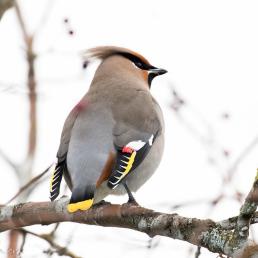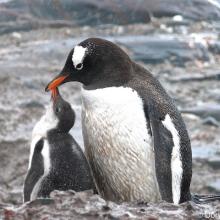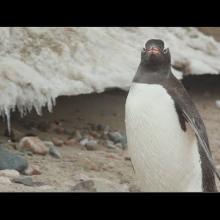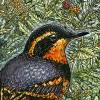

Join BirdNote tomorrow, November 30th!
Illustrator David Sibley and actor H. Jon Benjamin will face off in the bird illustration battle of the century during BirdNote's Year-end Celebration and Auction!
Gentoo Penguins are the fastest penguins in the world. A group of researchers used the penguin’s streamlined shape to design a new undersea robot called the Quadroin. This robo-penguin has sensors to measure ocean conditions and currents. It’s particularly suited to studying eddies, which are smaller and short-lived than major ocean currents but help draw nutrients to the ocean surface, supporting the marine food web.
BirdNote®
Meet the Robo-Penguin
Written by Conor Gearin
This is BirdNote.
[Gentoo Penguin calls, ML 203973661]
[Nature SFX 027 Surf Distant]
Gentoo Penguins look a little pear-shaped on land, but once they dive into the water, that shape lets them reach speeds of up to 22 miles per hour. They’re the fastest penguins in the world. It’d be difficult to build a vessel more streamlined than a penguin — so a group of researchers used the bird’s shape to design a new undersea robot.
[sfx: splash, water rushing past]
Called the Quadroin [kwa-DRO-in, rhymes with “Owen”], its 3D-printed body is wide in the middle and ends in a sharp, beak-like point. Four propellers at its tail let it maneuver nimbly.
The Quadroin is packed with sensors for measuring ocean conditions and currents. The big ocean currents capture most of our attention, like the East Australian Current seen in Finding Nemo.
ALT: The big ocean currents capture most of our attention, like the Gulf Stream.
[Finding Nemo clip https://www.youtube.com/watch?v=U6go9eFUIIU 0:00-0:13]
Alongside the major currents, though, are smaller spirals called eddies. They’re often short-lived, making them hard to study. But eddies are important: they draw nutrient-rich water to the surface, supporting the plankton that form the base of the entire marine food web.
By exploring eddies, these robo-penguins could help uncover much more about how they work and how they affect ocean ecosystems — and maybe shedding light on the processes that provide food for real sea creatures.
[Gentoo Penguin calls, ML 203973661]
For BirdNote, I’m Michael Stein.
###
Senior Producer: John Kessler
Content Director: Allison Wilson
Producer: Mark Bramhill
Associate Producer: Ellen Blackstone
Managing Producer: Conor Gearin
Bird sounds provided by The Macaulay Library of Natural Sounds at the Cornell Lab of Ornithology, Ithaca, New York. Gentoo Penguin ML 203973661 recorded by L. Demongin.
BirdNote’s theme was composed and played by Nancy Rumbel and John Kessler.
© 2022 BirdNote February 2022 Narrator: Michael Stein
ID: robot-02-2022-02-21 robot-02
References:<.p>
https://www.theguardian.com/environment/2021/aug/31/robo-penguin-self-p…







